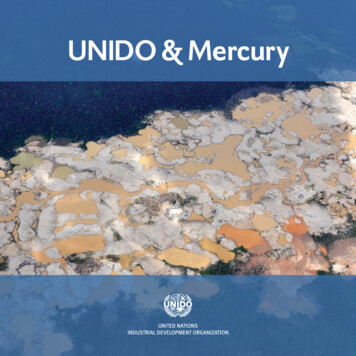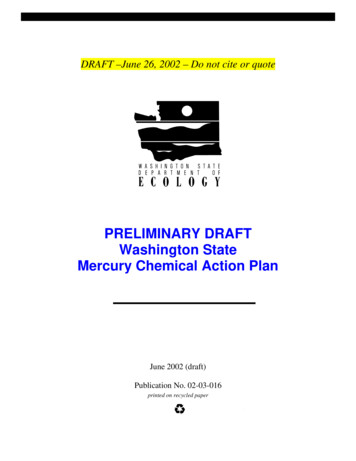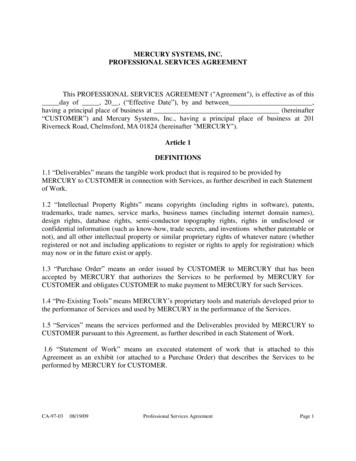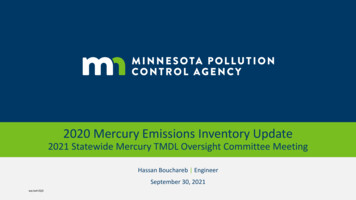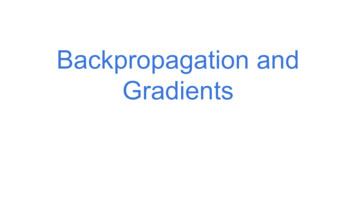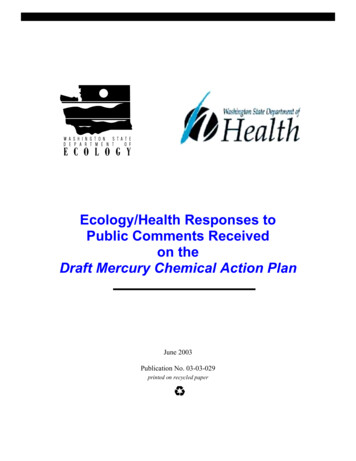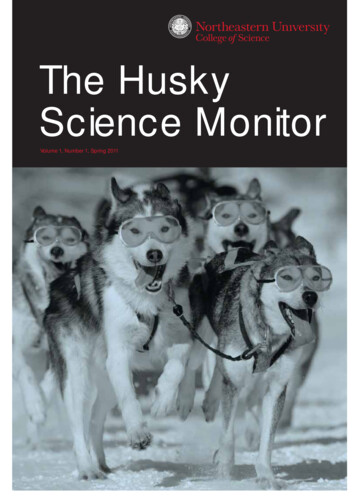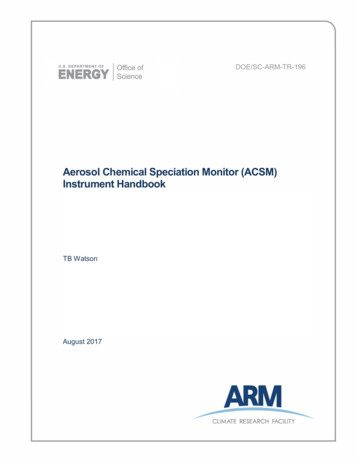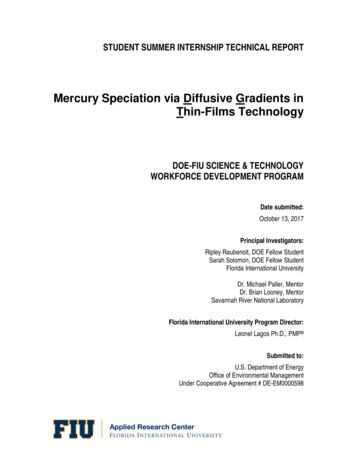
Transcription
STUDENT SUMMER INTERNSHIP TECHNICAL REPORTMercury Speciation via Diffusive Gradients inThin-Films TechnologyDOE-FIU SCIENCE & TECHNOLOGYWORKFORCE DEVELOPMENT PROGRAMDate submitted:October 13, 2017Principal Investigators:Ripley Raubenolt, DOE Fellow StudentSarah Solomon, DOE Fellow StudentFlorida International UniversityDr. Michael Paller, MentorDr. Brian Looney, MentorSavannah River National LaboratoryFlorida International University Program Director:Leonel Lagos Ph.D., PMP Submitted to:U.S. Department of EnergyOffice of Environmental ManagementUnder Cooperative Agreement # DE-EM0000598
DISCLAIMERThis report was prepared as an account of work sponsored by an agency of the United Statesgovernment. Neither the United States government nor any agency thereof, nor any of theiremployees, nor any of its contractors, subcontractors, nor their employees makes any warranty,express or implied, or assumes any legal liability or responsibility for the accuracy,completeness, or usefulness of any information, apparatus, product, or process disclosed, orrepresents that its use would not infringe upon privately owned rights. Reference herein to anyspecific commercial product, process, or service by trade name, trademark, manufacturer, orotherwise does not necessarily constitute or imply its endorsement, recommendation, or favoringby the United States government or any other agency thereof. The views and opinions of authorsexpressed herein do not necessarily state or reflect those of the United States government or anyagency thereof.
FIU-ARC-2017-800006473-04c-259Mercury Speciation Via Diffusive Gradients in Thin Films TechnologyABSTRACTMercury (Hg) is an environmental pollutant that behaves differently depending on the speciespresent. Methylmercury (MeHg) is one species of mercury that is a harmful bioaccumulativetoxin that needs a simple and affordable protocol for monitoring and risk assessment. A diffusivegradient in thin-films (DGT) technology is a rapid economical passive sampling techniquecapable of monitoring target contaminants in water. This study focused on identifying an optimalDGT for monitoring MeHg. A series of laboratory tests were conducted by selecting DGTprobes that: 1) sample total Hg by collecting both inorganic Hg and MeHg into a “standard”spheron-thiol resin layer (LSNB), 2) selectively sample organic MeHg using a hydrophobiccollection layer (LSND), and 3) selectively sample MeHg by incorporating reactions tomanipulate mercury chemistry along the diffusion path. The standard LNSB DGT was effectivein collecting both inorganic Hg and MeHg. The hydrophobic LSND DGT showed a slightpreference for MeHg over inorganic Hg; however, it did not exhibit sufficient selectivity foreffective-practical monitoring of MeHg. Applying mercury speciation chemistry within the DGTmaximized the MeHg uptake while minimizing the uptake of inorganic mercury. The resultingreactive DGT (rDGT) represents an effective and practical technology for selectively samplingMeHg in aqueous systems.iii
FIU-ARC-2017-800006473-04c-259Mercury Speciation Via Diffusive Gradients in Thin Films TechnologyTABLE OF CONTENTSABSTRACT. iiiTABLE OF CONTENTS . ivLIST OF FIGURES .vLIST OF TABLES .v1. INTRODUCTION .12. EXECUTIVE SUMMARY .33. RESEARCH DESCRIPTION .54. RESULTS AND ANALYSIS .105. CONCLUSION .146. FUTURE WORK .157. REFERENCES .16APPENDIX A. .17APPENDIX B. .19iv
FIU-ARC-2017-800006473-04c-259Mercury Speciation Via Diffusive Gradients in Thin Films TechnologyLIST OF FIGURESFigure 1. Simplified depiction of the role of mercury speciation in aquatic systems. . 1Figure 2. Schematic representation of a DGT and its cross- section illustrating Fick's Law. . 2Figure 3. Filter membranes being treated with colloidal gold. . 7Figure 4. Schematic and exploded view of a reactive DGT probe. . 8Figure 5. Reactive DGT probe using SnCl 2 reductant without top filter and cap. . 8Figure 6. Reactive DGT probe using Cu (0) reductant without top filter and cap. . 8Figure 7. Selective uptake of MeHg in reactive DGT. . 9Figure 8. Differential uptake comparison of all DGT probes tested. 13Figure 9. Biological relevance of a standard DGT and reactive DGT. 14Figure 10. Mercury concentration in water samples. . 18Figure 11. Mass of mercury collected over time obtained from preliminary test utilizing LSNB 18LIST OF TABLESTable 1. LSNB DGT Parameters . 12Table 2. LSNB DGT Exposed to 1200 ng Inorganic Mercury for Set Intervals of Time . 17v
FIU-ARC-2017-800006473-04c-259Mercury Speciation Via Diffusive Gradients in Thin Films Technology1. INTRODUCTIONMercury (Hg), organic and inorganic, is an important persistent-bioaccumulative-toxicenvironmental pollutant. The mercury species present correlates with characteristics such astoxicity, solubility, mobility and bioavailability (Pelcova et al., 2013). Organic mercury such asmethylmercury (MeHg) is one of the most toxic species of mercury effecting human and animalhealth. Hg in the environment can be found naturally, as well as a result of anthropogenicactivities such as mining, Hg manufacture and disposal, and fossil fuel combustion (FernandezGomez, et al., 2011).Mercury contamination has become a global concern due to its ability to be released into theatmosphere in one location and impact ecosystems thousands of kilometers away. As mercuryenters an aqueous system, it is subject to methylation or demethylation (Figure 1).Methylmercury is formed by sulphate reducing methogenic microorganisms. Methylmercurypartitions into peripyton, plankton and biota that are eaten by invertebrates and fish. As a result,mercury biomagnifies as it accumulates throughout the food chain.Figure 1. Simplified depiction of the role of mercury speciation in aquatic systems.Therefore, monitoring both total mercury and mercury species is important to assess due to theimpact on human and animal health as well as the environment. Additionally, understandingspatial and seasonal lability of Hg in the environment is important in a technicallt basedassessment of risks (Panichev and Panicheva, 2015). To help assess speciation of mercury inaqueous systems, a protocol utilizing diffusive gradients in thin films (DGT) technology, tocollect and concentrate total Hg and MeHg contaminants, has the potential reduce costs andincrease reliability of monitoring mercury.A DGT is a passive sampler that accumulates solutes through three encased layers: a filtermembrane, a diffusive hydrogel, and a “collection” resin hydrogel. When deployed in a solution,ions diffuse through the first two layers (diffusion zone) and bind to the ion-exchange resin(Fernandez-Gomez et al., 2011). The composition of the two gels correlate with the ions in the1
FIU-ARC-2017-800006473-04c-259Mercury Speciation Via Diffusive Gradients in Thin Films Technologysolution being studied (Fernandez-Gomez et al., 2011). For instance, the article Application ofDiffusion Gradient in Thin Films Technique (DGT) for Measurement of Mercury in AquaticSystems states that mercury has a high binding capacity with amide groups; thus, polyacrylamidegels cannot be used in the diffusion layer. Instead an agarose diffusion hydrogel replaces it andcan be coupled with a spheron-thiol resin that collects total mercury (Docekalova and Divis,2004). Exposing the DGT probe to a solution for a select amount of time (t) establishes aconcentration gradient that represents the amount of metal collected. In utilizing Fick’s first lawof diffusion, the mass (M) of mercury collected can be related to the solution concentrationthrough the following equation:𝐶𝐶𝐷𝐷𝐷𝐷𝐷𝐷 𝑀𝑀 𝑔𝑔𝐷𝐷𝐷𝐷𝐷𝐷(Eq. 1)Where 𝑔𝑔 is the thickness of the diffusion layer (cm), D is the diffusion coefficient (cm2/sec),and A is the surface area exposed to the solution (cm2) (DGT).Figure 2. Schematic representation of a DGT and its cross-section illustrating Fick's Law.The goal of this study is to identify a DGT probe capable of specifically measuringmethylmercury as well as develop a protocol to monitor total and organic mercury via in-situsampling in natural waters using DGT probes. Two approaches were taken. One approachconsisted of selecting DGT samplers based on their gel composition. An XAD18 resin and aHLB resin, intended for antibiotics, pesticides, and personal care products, were tested tomeasure methylmercury based on their ability to collect organic contaminants andmethylmercury’s octanol-water partition coefficient being similar to that of organiccontaminants. A commonly used spheron-thiol resin was selected based on effectiveness inmeasuring total mercury in previous studies. The second approach was to apply mercuryspeciation chemistry by modifying the original DGT, creating a reactive DGT containing aspheron-thiol resin by adding an amalgamation layer that was incorporated into the diffusivezone. Here, inorganic mercury was reduced to elemental mercury and then removed throughamalgamation. The resin of the DGT samples were analyzed via the Lumex RA915 Zeeman2
FIU-ARC-2017-800006473-04c-259Mercury Speciation Via Diffusive Gradients in Thin Films Technologyeffect spectrometer; a pyrolytic technique that converts all mercury to elemental mercury todetermine mercury concentration within a sample. Results were then assessed to determineviability.2. EXECUTIVE SUMMARYThis research work has been supported by the DOE-FIU Science & Technology WorkforceInitiative, an innovative program developed by the US Department of Energy’s EnvironmentalManagement (DOE-EM) and Florida International University’s Applied Research Center (FIUARC). During the summer of 2017, DOE Fellow interns Sarah Solomon and Ripley Raubenoltspent 10 weeks doing a summer internship at Savannah River Site’s Aiken County TechnologyLaboratory under the supervision and guidance of Dr. Michael Paller and Dr. Brian Looney. Theinterns’ project was initiated on June 5, 2017, and continued through August 11, 2017 with theobjective of developing a protocol for utilizing diffusive gradients in thin-films (DGT) formercury quantification/speciation as well as identifying a DGT probe effective in selectivelymeasuring methylmercury (MeHg).3
FIU-ARC-2017-800006473-04c-259Mercury Speciation Via Diffusive Gradients in Thin Films Technology4
FIU-ARC-2017-800006473-04c-259Mercury Speciation Via Diffusive Gradients in Thin Films Technology3. RESEARCH DESCRIPTIONApparatusThe DGT’s were supplied by DGT Research Ltd, Lancaster A2 0QJ, UK. Initially, threedifferent DGT probes were tested: Probe Type 1(LSNBn) containing a spheron-thiol resinintended for total mercury, Probe Type 2 (LSND) containing an XAD18 collection resinintended for antibiotics, and Probe Type 3 (LSNC) containing an HLB collection resin intendedfor pesticides and personal care products. The resin of the DGT samples were analyzed via theLumex RA915 Zeeman effect spectrometer which uses a pyrolytic technique that converts allmercury to elemental mercury to determine mercury concertation within a sample.Preparation of Standards and Artificial Stream Water for TestsStandards for MeHg and InHg of 1 mg/L (as Hg) were prepared. Artificial stream water wasmade in 10 L batches using Nalgene containers by mixing 0.01 g of potassium chloride, 0.307 gof magnesium sulfate heptahydrate, 0.150 g of calcium sulfate dehydrate, and 0.240 g of sodiumbicarbonate in NANOpure Diamond deionized water with a conductivity of 18.2 megaohms-cm.Basic DGT Performance Tests and Sample Campaign RunTo test the validity of the DGT’s with the Lumex for measuring mercury concentrations,standard calibration tests were run. DGT resins were spiked with a known amount of mercurystandard and placed in the Lumex glass ladles for analysis. This same procedure was also donewith standard water samples spiked with the same amount. The standards were tested in theLumex to create calibration curves for MeHg and InHg. Calibration curves for Probe Type 1were compared to data obtained in previous experiments. Similar calibration curves weredeveloped for Probes 2 and 3. To become comfortable with future campaign procedures, a testrun was set up using four beakers and four DGT probes. A concentration of 1200 ng/L Hg wasspiked into each beaker containing 3.8L of gently stirred artificial stream water. DGT’s wereretrieved at 24, 48, and 113 hours and placed into ladles to be analyzed by the Lumex.Initiation of Campaign 1 and 2 and Immersion Solution PreparationSeven 4L beakers were washed with nitric acid and allowed to dry. Artificial stream watersolution was poured into each beaker and spiked with Hg standards to create a 1200 mg/Lconcentration of inorganic mercury, methylmercury, and a solution containing 50% of each; 5.71mL for methylmercury and 4.56 mL for inorganic mercury. A magnetic stir bar was placed ineach beaker which was then placed on a stir plate set on a low speed to allow for gentle mixing.The solutions in each beaker equilibrated before placing the DGT’s into the beakers tocompensate for mercury stability. For the first campaign run, Probe Types 1 and 2 were tested.For the second campaign run, Probe Type 3 and an older Type 1, for comparison, were tested.5
FIU-ARC-2017-800006473-04c-259Mercury Speciation Via Diffusive Gradients in Thin Films TechnologyDGT DeploymentThe DGT probes were taken out of the cold room (39 F) and removed from their polyethylenebags without contaminating the white face filter membrane. Monofilament was attached to theholes in the base of the DGTs so they could be hung inside the beakers. The probes were thenfully immersed into the beakers. Each beaker contained 2 DGTs, for the purpose of duplicationand verifying that results were consistent for each probe type. Water samples of each beaker foreach campaign were taken (250 mL) and the DGT probes were immersed for 48 hours.Preparation of Bromine Monochloride for Analysis ProceduresTo preserve the samples and convert the organic mercury in the water samples to an elementalstate, 1 mL of bromine monochloride (BrCl) was added to each water sample. The reagent wasprepared as described in EPA Method 1631. After the water samples were preserved withbromine monochloride, they were analyzed using EPA Method 7470. Water samplesrepresentative of the deployment and harvesting were collected during campaigns 1 through 4.The deployment/harvest concentrations were averaged and the resulting values were used in theDGT equation for interpreting the various tests. Water concentrations for the trial run wereestimated based on regression of the deployment/harvest measurements of inorganic mercury inthe later campaigns (see Appendix A).Pyrolysis Analysis of Solid Samples using the Lumex 915 All samples were analyzed using the Lumex RA-915 Zeeman Effect Spectrometer equippedwith a Lumex RP 91C solids (desorption/pyrolysis) attachment. The quartz ladles were linedwith aluminum foil and placed in the instrument to bake out any preexisting mercury. Eachsample/standard was placed on the aluminum foil and covered with approximately 1.5 g of amixed powder of sodium carbonate (NaCO 3 ) and copper oxide (CuO) – 50% each by mass. Themixed powder was then placed in the oven at 95 C for 24 hours before use. Use of the powderreduced smoke formation and aided in converting all of the mercury in the samples intoelemental mercury for accurate detection. The loaded ladles were placed in the instrument andheated to 700 C for 130sec. Mercury was released into the spectrometer for quantitation.DGT Processing and AnalysisAt the end of the proposed time periods, the DGT’s were retrieved from the beakers withouttouching the white face filter membrane. The probes were then rinsed with deionized water andshaken to remove any surface water still present. The DGT’s that were not being analyzedimmediately were placed in individual polyethylene bags with minimum air space. Each bag waslabeled and stored in the cold room. During analysis, the probes were removed from the coldroom and taken out of their individual bags. The cap of the probe was twisted open and thehydrogel resin was obtained. The resin was then placed in a clean glass ladle lined withaluminum foil and covered with the NaCO 3 and CuO mix.After the data was received, the performance of each probe was assessed by estimating anapparent diffusion coefficient, D*, using equation (2). If the DGT is performing well, then D*will be similar to the theoretical value and within the bounds of the values measured in theliterature for mercury DGTs. Low values of D* indicate that the DGT is not effectively6
FIU-ARC-2017-800006473-04c-259Mercury Speciation Via Diffusive Gradients in Thin Films Technologycollecting the analyte. In this case, a low D* indicates that: 1) the target mercury is not beingeffectively and completely taken up by the collection gel and/or, 2) mercury is being trapped inthe diffusion zone (e.g, by sorption to the filter or gel).𝐷𝐷 𝑀𝑀 𝑑𝑑(Eq. 2)Where g is the sum of the diffusive gel layer thickness and the filter membrane thickness, M isthe mass of Hg collected onto the gel, D is the diffusion coefficient of Hg in the gel, t is thedeployment time, and A is the exposure area.Preparation of Modified DGT’s for More Efficient MeHg UptakeStannous ChlorideThe data received from campaigns 1 and 2 suggested that the spheron-thiol resin could not beused to selectively uptake MeHg as the strength of the differential signal was not sufficient. Aresin gel with a stronger affinity for methyl uptake and minimal inorganic uptake was needed.Using mercury speciation chemistry and the concept of amalgamation, a method was developedto remove the diffusing inorganic mercury while allowing the methylmercury to diffuse into theresin gel. Additional filter membranes were obtained from excess Type 3 probes to create anadditional filter layer underneath the present one. The underlying additional filter wasconditioned with colloidal gold (3 nm) by soaking it in about 20 ppm of solution (Figure 3) andallowing the filter to dry by placing it in an oven at 95 C for about 3 hours.Figure 3. Filter membranes being treated with colloidal gold.Stannous chloride powder was then prepared and finely ground using a mortar and pestle. About0.1 g of the powder was placed in between the two filters to encourage amalgamation betweenthe mercury and colloidal gold before the immersion solution met the diffusion layer. This setupis shown in Figure 4 and the resulting DGT in Figure 5. The DGT’s were then deployed andretrieved using the same methods as in campaigns 1 and 2.7
FIU-ARC-2017-800006473-04c-259Mercury Speciation Via Diffusive Gradients in Thin Films TechnologyFigure 4. Schematic and exploded view of a reactive DGT probe.Figure 5. Reactive DGT probe using SnCl 2 reductant without top filter and cap.Copper MetalThe data received from campaign 3 suggested that there was an increase in MeHg uptake and adecrease in InHg uptake as a result of using colloidal gold and stannous chloride. However, thestannous chloride created more precipitate then desired and could have had a possible negativeeffect on the MeHg uptake efficiency. This led to the development of campaign 4. To preventprecipitate from forming, 0.16 g of copper metal powder was placed on top of each treated filter,instead of stannous chloride. The filter membrane was conditioned using the same procedure asin campaign 3 and is shown Figure 6.Figure 6. Reactive DGT probe using Cu (0) reductant without top filter and cap.Theory of the Reactive DGTThe principle behind the development of a reactive DGT is to create a DGT that can differentiatemercury species using resin gels that are commercially available. The new reactive DGT8
FIU-ARC-2017-800006473-04c-259Mercury Speciation Via Diffusive Gradients in Thin Films Technologyincorporates targeted chemical reactions to differentiate key mercury species. The reactive DGTswere manipulated to selectively measure either methylmercury by manipulating inorganicmercury behavior through the combined processes of chemical reduction and amalgamation. Themethylmercury rDGT removes inorganic mercury using these reactions along the diffusive path– allowing methylmercury to freely move to the standard thiol based resin gel (Figure 7). Formercury speciation, the rDGT provides a quick, low cost alternative to complicated, timeconsuming and expensive laboratory methods currently used.Figure 7. Selective uptake of MeHg in reactive DGT.An additional filter membrane is added to the front of the DGT and a reductant (tin(II) chlorideor Cu(0)) is added in the space created. The reductant converts incoming inorganic ionic mercuryto elemental. Elemental mercury will then adhere to the colloidal gold on the underlying treatedfilter through amalgamation, stopping the elemental mercury from moving into the diffusionlayer.9
FIU-ARC-2017-800006473-04c-259Mercury Speciation Via Diffusive Gradients in Thin Films Technology4. RESULTS AND ANALYSISCampaigns 1 and 2 supported the initial hypothesis; more MeHg was collected by thehydrophobic DGT (Probe Type 2) in comparison to the uptake of InHg. However, the differentialuptake between the two species was not significant and there was an observable limitedcollection efficiency with Probe Type 2 in comparison with Probe Type 1 and Probe Type 4.These results would not support the practical application or development of a Type 2 basedMeHg DGT. Probe Types 1 and 4 collected significantly higher amounts of MeHg and InHg butthe differential uptake between the two species was also not significant for practical application.The data from campaigns 1 and 2 also showed a decrease in collection efficiency of Probe Type4, indicating that the resins lose their uptake efficiency over time. Type 3 data was omittedbecause background levels in the Lumex were out of specification due to deposits collecting onthe cell windows.Campaign 3 supported the second hypothesis and that the principle behind the reactive DGT(rDGT) is effective. The differential uptake between the species was significantly larger in ProbeType 5 and Probe Type 6 in comparison to the probes in campaign 1 and 2. The amount ofMeHg collected in Probe Type 5 was almost equivalent to Probe Type 1. Probe Type 6 collectedless MeHg then Probe Type 1 and Probe Type 4; this may be due to the precipitate, tin oxide(SnO 2 ), produced by the SnCl 2 reductant diffusing out into the immersion solution.Campaign 4 showed a significant improvement in the differential uptake between MeHg andInHg with a change in reductant from SnCl 2 to Cu(0). The reactive copper DGT, Probe Type 7,accumulated an average of 30.83 ng of methylmercury while Probe Type 6 had an averagemercury accumulation of 22.54 ng of methylmercury. It was observed that in utilizing Cu(0) as areductant, no precipitation or diffusion of copper was observed in the immersion solution, whichcould be an indication of better performance. To ensure rDGT performance, further testing isneeded. In comparing all probes, Probe Types 1 and 5 had the largest MeHg uptake, while ProbeTypes 5 and 6 showed the greatest potential for practical applications of a reactive DGT that willselectively uptake only MeHg.10
FIU-ARC-2017-800006473-04c-259Mercury Speciation Via Diffusive Gradients in Thin Films TechnologyTable 1. Overall Results for DGT TestingProbe TypeDescriptionControl LSNB - ALSNBStandard DGT fortotal mercury(practice run)LSNB newStandard DGTfor total mercuryin waterLSNDStandar DGT forantibiotics inwaterLSNB oldStandard DGTfor total mercuryin waterControl LSNB - BM (ng)Ci(ng/cm3)Cf(ng/cm3)0InHg LSNB -A8.640InHg LSNB - B17.618InHg LSNB - C41.853Control LSNBn - A4.404Control LSNBn - B4.620InHg LSNBn - A36.012InHg LSNBn - B31.260MeHg LSNBn - A49.548MeHg LSNBn - B41.052MixHg LSNBn - A30.828MixHg LSNBn - B37.092Control LSND - A-5.568Control LSND - B5.628LSND InHg- A3.828LSND InHg - B2.460LSND MeHg - A12.252LSND MeHg - B11.100LSND Mix Hg - A7.644LSND Mix Hg - B17.364Control LSNBo - A-2.364Control LSNBo - B-3.7176InHg LNSBo - A22.692InHg LNSBo - B15.060AVE. C(ng/cm3)A 11.310.4960.094n/a3.141.1n/a1.221.330.52486400D (cm2/sec)n/a0.023.140.557Δg(cm)01.14390.02t (sec)1728000.094n/a4.9263E-063.2695E-06
FIU-ARC-2017-800006473-04c-259LSNB SnCl2reactive rDGTwith tin(II)/Aureduction andamaglamationLSNB 2FStandard DGTfor total mercuryin water w/ addedfilterLSNB Cureactive rDGTwith Cu(0)/Aureduction andamaglamationMercury Speciation Via Diffusive Gradients in Thin Films TechnologyMeHg LNSBo - A43.932MeHg LNSBo - B29.892MixHg LNSBo - A21.540MixHg LNSBo - B29.388Control LSNBmod - A-0.035Control LSNBmod - B-0.860InHg LSNBmod - A-0.860InHg LSNBmod - B-2.735MeHg LSNBmod - A15.040MeHg LSNBmod - B30.040Control LSNB2F - A-1.910Control LSNB2F - B-3.935InHg LSNB2F - A16.765InHg LSNB2F - B12.190MeHg LSNB2F - A51.190MeHg LSNB2F - B45.265Control LNSBcu - A0.052Control LNSBcu - B-0.388InHg LNSBcu - A-0.278InHg LNSBcu - B-0.146MeHg LNSBcu - A37.100MeHg LNSBcu - 2.658E-084.7232E-063.1267E-06
FIU-ARC-2017-800006473-04c-259Mercury Speciation Via Diffusive Gradients in Thin Films TechnologyFigure 8. Differential uptake comparison of all DGT probes tested.13
FIU-ARC-2017-800006473-04c-259Mercury Speciation Via Diffusive Gradients in Thin Films Technology5. CONCLUSIONThe purpose of this study was to identify a DGT probe that could be used to selectively measuremethylmercury as well as develop a protocol to measure total and organic mercury via in-situsampling in natural waters using DGT probes. This was done by running multiple campaigns thattested 3 different resins and manipulated the uptake of mercury species by modifying the DGTlayers. The modified, reactive DGTs showed the greatest potential for being used to selectivelymeasure methylmercury.The new reactive DGT, in theory, has more biological relevance than the standard DGTscurrently used. Standard DGTs are used to report the total mercury content in a biological samplewhich includes both organic and inorganic species. However, the bioaccumulative presence ofmercury throughout the food chain is derived by methylmercury. Thus, reporting methylmercurycontent in the environment would enhance risks assessment of human and environmental health,and advance the ability to monitor, understand and mitigate mercury in contaminated streams,rivers, and lakes. Figure 9 demonstrates how the new reactive DGT is more reflective of howmercury speciation occurs in the environment and biological uptake.Figure 9. Biological relevance of a standard DGT and reactive DGT.14
FIU-ARC-2017-800006473-04c-259Mercury Speciation Via Diffusive Gradients in Thin Films Technology6. FUTURE WORKFuture studies on using DGTs for mercury speciation could further explore identifying anoptimal reductant [such as Zn (0) or Cu (0)] for reactive DGT to measure only methylmercury.Examination of alternative configurations of the reactive DGT could also be studied since onlytwo configurations were looked at in this study. Follow up experiments should also be performedto test the reactive DGT shelf life, effective deployment time, DOC, optimal pH, varying Hgconcentration, and speciation correlation to fish uptake. Further assessment of measuringmercury with DGT technology as a low cost rapid assessment monitoring technique should alsobe done. SRS wil
mercury to elemental mercury to determine mercury concertation within a sample. Preparation of Standards and Artificial Stream Water for Tests . Standards for MeHg and InHg of mg/L (as Hg) 1 were prepared. Artificial stream water was made in 10 L batches using Nalgene containers by mixing 0.01 g of potassium chloride, 0.307 g
